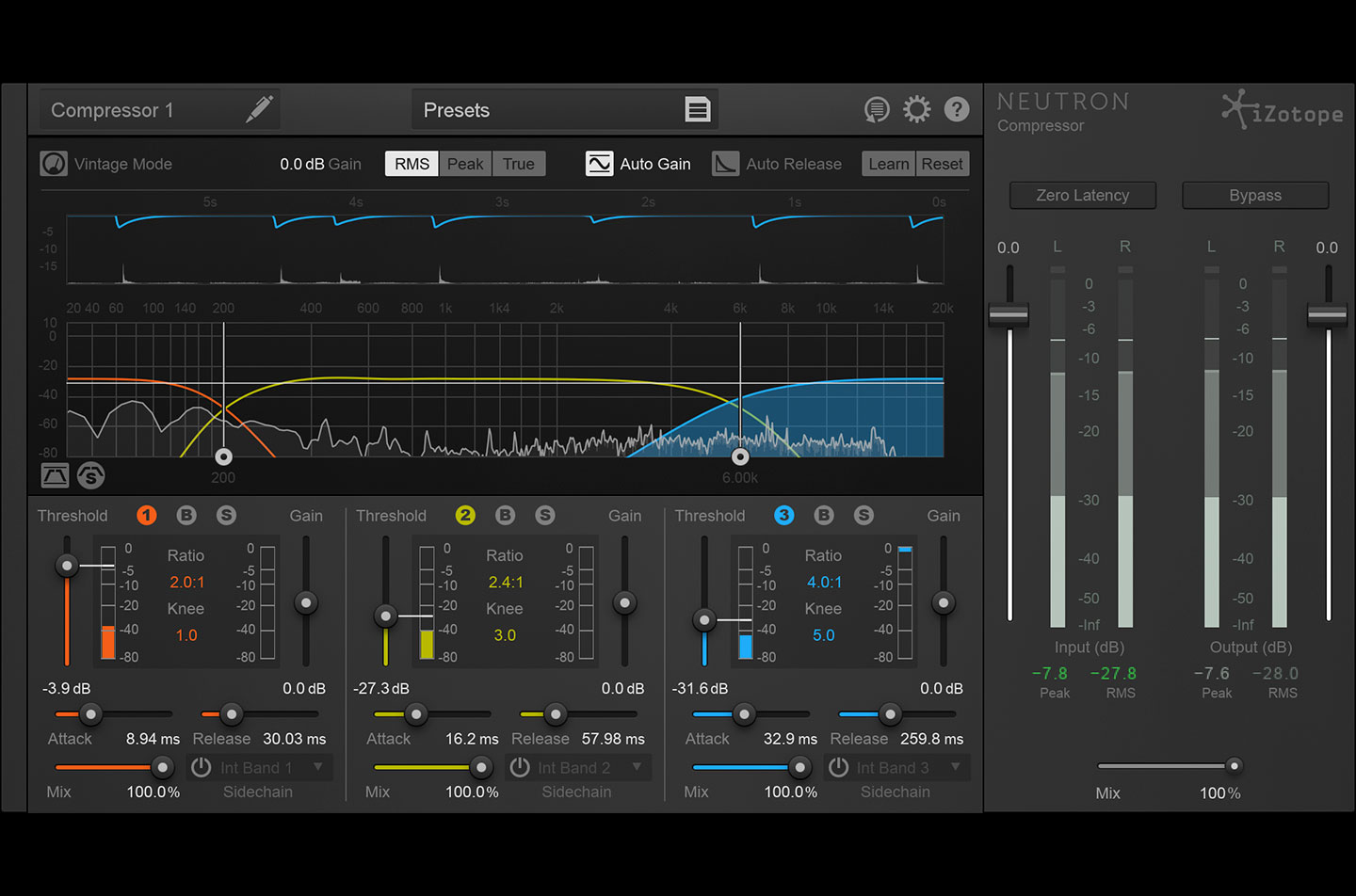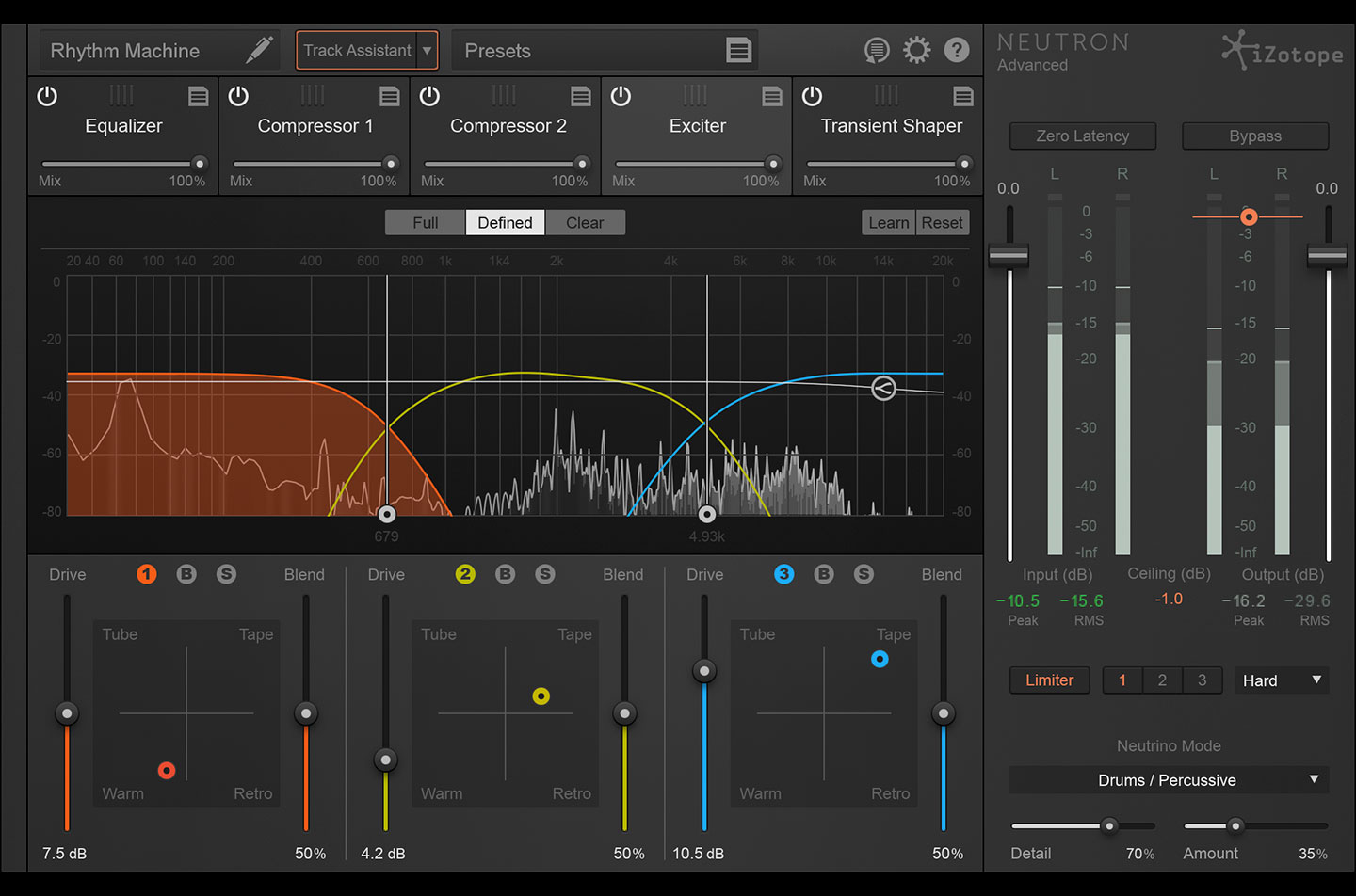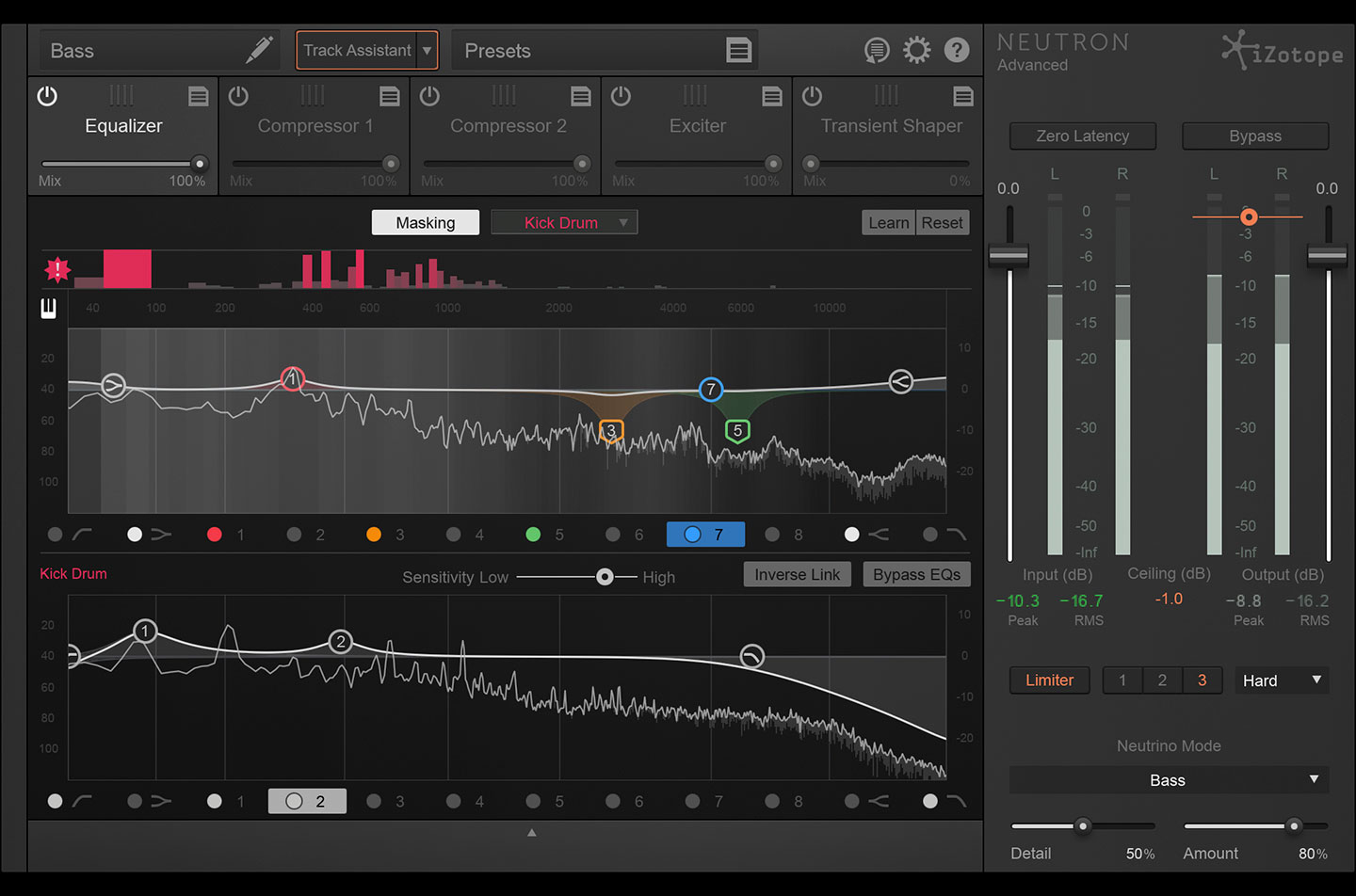- How do you feel about presets? Are you a staunch believer that they should be avoided at all costs? Or do you think your productions can be enhanced by creations from dedicated sound designers? Perhaps you're somewhere in the middle and think that, while presets can provide an inspirational starting point, you favour editing and shaping those settings to better fit the individual needs of your track.
Presets within synthesizers and sound-generating plug-ins have existed for many years, but the idea of preset starting points for audio processing—EQ, compression and other sound-shaping tools—is a newer phenomenon that draws understandable suspicion. How can a mastering plug-in know the individual requirements of your mix? How can a compression preset called "Better Snare Drum" know whether your source sound is an acoustic smack or an electronic blast? Settings that work in one context might not in another.
iZotope's new Neutron plug-in tries to find a middle-ground approach to presets. Using intelligent tools and audio analysis, it assesses the sounds you're processing and then offers settings designed to improve your mix. But as iZotope are keen to stress, these results shouldn't be considered a complete and final solution but rather the first few steps on the road to a finished mix. In this review, we're looking at Neutron Advanced, which, as its name suggests, is the most comprehensive version of the Neutron experience. There's a free, very simple tool for frequency shaping, called Neutrino (based on Neutron's technology), as well as a standard Neutron version. The main differences between Neutron and its Advanced equivalent are support for 7.1 surround mixing and separate plug-in components being available outside of the host in the latter. For more detail, check the comparison chart on iZotope's website.
Anyone familiar with iZotope's Ozone software will be comfortable here, as there are several similarities between the programs. In short, Neutron offers a modular approach to effects processing, letting you chain together up to five effects in the order of your choice, which include EQ, compression, an exciter, transient shaping and so on. Clicking on any of these modules allows you to see their parameters, providing a comprehensive opportunity to shape each stage of the processing chain in detail. Dragging them to the left or right reorders the signal flow, but the underlying signal path runs as follows: you have control of the input gain for up to five processing modules, then spectral shaping, an output gain stage and finally a limiter. It's a pretty comprehensive setup, but we're just getting started.
Neutron wants to help you reach settings that might suit your mix more quickly than starting from scratch, and this is where the Track Assistant feature comes in. By clicking the Track Assistant button, you can launch an analysis mode that examines source audio for a few seconds after you press play. It looks at frequency content, transients and dynamics, and upon completion, you'll find that Neutron will have set up its own chain of effects with parameter settings tuned for each module. You can predetermine the approach you'd like the analysis to take, with Subtle, Medium and Aggressive settings. As Neutron's modules all feature Mix Blend dials, you could use the Aggressive setting to analyse and produce a parallel treatment, while you might use Subtle on a 100% wet setting to get you started on the mix for a whole track.
The algorithm at the heart of Track Assistant can be set to track Vocals/Dialogue, Guitar, Bass, Drums/Percussive or a setting called Clean. Its detection is extremely accurate, unless you feed it deliberately obscured source material, whose results can be interesting in their own right. The effects chain that Neutron produces goes as far as placing appropriate crossover frequency points for its multi-band modules. You can also choose from a range of frequency-sensitive algorithms: Broadband Clarity (great for sorting out murk and mud from a source sound), Warm And Open (punch and body are favoured here, alongside a variable compression strength) or Upfront Midrange (with mid content and brighter, airier and wider EQ enhancements). You can even go back in time if Track Assistant's settings produce a sub-optimal result, as there's an undo history function onboard. If you don't like the idea of Track Assistant but you do want preset starting points, over 500 are available via the Preset Browser, with options on a per-instrument basis.
Each mix module is comprehensively spec'd with parameters. The EQ offers up to eight bell curve nodes, in addition to high and low shelves and high-pass and low-pass filters. Each band can feature band-shelf or proportional Q curves—better still, each can be switched to become dynamic, effectively turning the EQ into a multi-band compressor with frequency-sensitive dynamics control. The transient shaper can work in single-, dual- or triple-band modes, with sharp, medium and smooth curves and independent attack and sustain sliders. There are two compressors available but both have the same feature set, with up to three bands, a choice of frequency crossover points, independent thresholds, ratios, attack and release times and, pleasingly, independent side-chain input sources. Also, each band has a mix control, making this an extremely sophisticated tool for careful parallel compression treatments.
The exciter also has three bands, each featuring an XY axis panel to set a balance between retro, tape, warm and tube settings, as well ass independent drive and blend dials. The limiter in the output section is simple but effective. Three options are available, which vary the sonic character of the signal at the output stage, while three algorithms are also offered to set a balance between accuracy and latency.
Here are some before and after examples of how a combination of processes can enhance various elements in your work.
Both Neutron and Neutron Advanced also offer Masking Meter, which is another analysis tool designed to help improve your mixes. Mix engineers have to make allowances for frequency masking on a daily basis. In simple terms, this is the phenomenon that occurs when two sounds with overlapping frequency (and to some extent dynamic) content play at the same time. Masking is unavoidable in modern mixing and, of course, not all of it is bad—think of the relationship between a kick drum and a bassline, and the inevitability that, unless their programmed parts keep their notes apart, some frequencies will overlap. Too much masking, however, makes a mix sound confused, with elements fighting for space and clarity.
To use Neutron's Masking Meter (accessed through the EQ module), you simply need to set it up on a minimum of two separate tracks in your mix. You can name each Neutron instance, which is advisable, since, having done so, you can then select the name of the second track in the window of the first. Analysis tools then go to work on both signals, and then a graphical representation of which frequencies are competing—and how severely—is displayed. Of course, if you have several instances of Neutron running, you can toggle between multiple tracks (although only compare two at a time) to contrast masking between, for instance, a kick drum and a bassline or a low pad. iZotope are rightly keen to stress that the Masking Meter's analyser shouldn't be used to identify and then immediately remove all overlapping frequencies. It's meant to be a helping hand to track those frequencies down before deciding how to deal with any issues.
I'll admit that I was skeptical about Neutron. I was concerned that it was going to guide me to a one-size-fits-all approach to mixing, which would show its limitations quickly. But I'm hugely impressed. Provided you do as iZotope recommend and treat the results of Track Assistant as a jumping off point rather than a finished solution, there's an awful lot of control here. In fact, even if you're looking for a mixing suite of effects yet wouldn't countenance the idea of a plug-in making settings suggestions for you, I'd still look twice at Neutron. Its modules are full of well-considered and comprehensive parameters, and there's no doubting the quality of its Masking Meter's analysis. It should appeal to producers, mix engineers and post-production facilities alike. There's plenty here to make your mixes sound a whole lot better.
Ratings:
Cost: 3.9
Versatility: 4.8
Ease of use: 4.0
Sound: 4.5
 The exciter also has three bands, each featuring an XY axis panel to set a balance between retro, tape, warm and tube settings, as well ass independent drive and blend dials. The limiter in the output section is simple but effective. Three options are available, which vary the sonic character of the signal at the output stage, while three algorithms are also offered to set a balance between accuracy and latency. Here are some before and after examples of how a combination of processes can enhance various elements in your work. Both Neutron and Neutron Advanced also offer Masking Meter, which is another analysis tool designed to help improve your mixes. Mix engineers have to make allowances for frequency masking on a daily basis. In simple terms, this is the phenomenon that occurs when two sounds with overlapping frequency (and to some extent dynamic) content play at the same time. Masking is unavoidable in modern mixing and, of course, not all of it is bad—think of the relationship between a kick drum and a bassline, and the inevitability that, unless their programmed parts keep their notes apart, some frequencies will overlap. Too much masking, however, makes a mix sound confused, with elements fighting for space and clarity. To use Neutron's Masking Meter (accessed through the EQ module), you simply need to set it up on a minimum of two separate tracks in your mix. You can name each Neutron instance, which is advisable, since, having done so, you can then select the name of the second track in the window of the first. Analysis tools then go to work on both signals, and then a graphical representation of which frequencies are competing—and how severely—is displayed. Of course, if you have several instances of Neutron running, you can toggle between multiple tracks (although only compare two at a time) to contrast masking between, for instance, a kick drum and a bassline or a low pad. iZotope are rightly keen to stress that the Masking Meter's analyser shouldn't be used to identify and then immediately remove all overlapping frequencies. It's meant to be a helping hand to track those frequencies down before deciding how to deal with any issues.
The exciter also has three bands, each featuring an XY axis panel to set a balance between retro, tape, warm and tube settings, as well ass independent drive and blend dials. The limiter in the output section is simple but effective. Three options are available, which vary the sonic character of the signal at the output stage, while three algorithms are also offered to set a balance between accuracy and latency. Here are some before and after examples of how a combination of processes can enhance various elements in your work. Both Neutron and Neutron Advanced also offer Masking Meter, which is another analysis tool designed to help improve your mixes. Mix engineers have to make allowances for frequency masking on a daily basis. In simple terms, this is the phenomenon that occurs when two sounds with overlapping frequency (and to some extent dynamic) content play at the same time. Masking is unavoidable in modern mixing and, of course, not all of it is bad—think of the relationship between a kick drum and a bassline, and the inevitability that, unless their programmed parts keep their notes apart, some frequencies will overlap. Too much masking, however, makes a mix sound confused, with elements fighting for space and clarity. To use Neutron's Masking Meter (accessed through the EQ module), you simply need to set it up on a minimum of two separate tracks in your mix. You can name each Neutron instance, which is advisable, since, having done so, you can then select the name of the second track in the window of the first. Analysis tools then go to work on both signals, and then a graphical representation of which frequencies are competing—and how severely—is displayed. Of course, if you have several instances of Neutron running, you can toggle between multiple tracks (although only compare two at a time) to contrast masking between, for instance, a kick drum and a bassline or a low pad. iZotope are rightly keen to stress that the Masking Meter's analyser shouldn't be used to identify and then immediately remove all overlapping frequencies. It's meant to be a helping hand to track those frequencies down before deciding how to deal with any issues. I'll admit that I was skeptical about Neutron. I was concerned that it was going to guide me to a one-size-fits-all approach to mixing, which would show its limitations quickly. But I'm hugely impressed. Provided you do as iZotope recommend and treat the results of Track Assistant as a jumping off point rather than a finished solution, there's an awful lot of control here. In fact, even if you're looking for a mixing suite of effects yet wouldn't countenance the idea of a plug-in making settings suggestions for you, I'd still look twice at Neutron. Its modules are full of well-considered and comprehensive parameters, and there's no doubting the quality of its Masking Meter's analysis. It should appeal to producers, mix engineers and post-production facilities alike. There's plenty here to make your mixes sound a whole lot better. Ratings: Cost: 3.9 Versatility: 4.8 Ease of use: 4.0 Sound: 4.5
I'll admit that I was skeptical about Neutron. I was concerned that it was going to guide me to a one-size-fits-all approach to mixing, which would show its limitations quickly. But I'm hugely impressed. Provided you do as iZotope recommend and treat the results of Track Assistant as a jumping off point rather than a finished solution, there's an awful lot of control here. In fact, even if you're looking for a mixing suite of effects yet wouldn't countenance the idea of a plug-in making settings suggestions for you, I'd still look twice at Neutron. Its modules are full of well-considered and comprehensive parameters, and there's no doubting the quality of its Masking Meter's analysis. It should appeal to producers, mix engineers and post-production facilities alike. There's plenty here to make your mixes sound a whole lot better. Ratings: Cost: 3.9 Versatility: 4.8 Ease of use: 4.0 Sound: 4.5